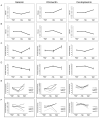Changes in the plasma proteome follows chronic opiate administration in simian immunodeficiency virus infected rhesus macaques
- PMID: 21821369
- PMCID: PMC3245805
- DOI: 10.1016/j.drugalcdep.2011.07.009
Changes in the plasma proteome follows chronic opiate administration in simian immunodeficiency virus infected rhesus macaques
Abstract
Background: Substantive plasma proteomic changes follow lentiviral infection and disease pathobiology. We posit that such protein alterations are modified during drug abuse, further serving to affect the disease. To this end, we investigated the effect of opiate administration on the plasma proteome of Indian-strain rhesus monkeys infected with simian immunodeficiency virus (SIV) strain smm9.
Methods: Whole blood was collected at 7 weeks prior to and 1.4 and 49 weeks after viral infection. Viral load, CD4(+) T cell subsets, and plasma protein content were measured from monkeys that did or did not receive continuous opiate administrations. The plasma proteome was identified and quantified by isobaric tags for relative and absolute quantitation labeling (iTRAQ) and mass spectrometry.
Results: While substantive changes in plasma proteins were seen during SIV infection, the addition of opiates led to suppression of these changes as well as increased variance of the proteome. These changes demonstrate that opiates induce broad but variant immune suppression in SIV-infected monkeys.
Conclusion: The broad suppressive changes seen in plasma of SIV-infected monkeys likely reflect reduced multisystem immune homeostatic responses induced by opiates. Such occur as a consequence of complex cell-to-cell interactions operative between the virus and the host. We conclude that such changes in plasma proteomic profiling may be underappreciated and as such supports the need for improved clinical definitions.
Copyright © 2011 Elsevier Ireland Ltd. All rights reserved.
Figures



Similar articles
-
Plasma proteomic analysis of simian immunodeficiency virus infection of rhesus macaques.J Proteome Res. 2010 Sep 3;9(9):4721-31. doi: 10.1021/pr1004345. J Proteome Res. 2010. PMID: 20677826 Free PMC article.
-
Effect of morphine on the neuropathogenesis of SIVmac infection in Indian Rhesus Macaques.J Neuroimmune Pharmacol. 2008 Mar;3(1):12-25. doi: 10.1007/s11481-007-9085-z. Epub 2007 Sep 13. J Neuroimmune Pharmacol. 2008. PMID: 18247128
-
Route of simian immunodeficiency virus inoculation determines the complexity but not the identity of viral variant populations that infect rhesus macaques.J Virol. 2001 Apr;75(8):3753-65. doi: 10.1128/JVI.75.8.3753-3765.2001. J Virol. 2001. PMID: 11264364 Free PMC article.
-
Titration of an SIVmac251 stock by vaginal inoculation of Indian and Chinese origin rhesus macaques: transmission efficiency, viral loads, and antibody responses.AIDS Res Hum Retroviruses. 2001 Oct 10;17(15):1455-66. doi: 10.1089/088922201753197123. AIDS Res Hum Retroviruses. 2001. PMID: 11679158 Free PMC article.
-
Effect of bacterial pneumonia on lung simian immunodeficiency virus (SIV) replication in alcohol consuming SIV-infected rhesus macaques.Alcohol Clin Exp Res. 2013 Jun;37(6):969-77. doi: 10.1111/acer.12070. Epub 2013 Feb 15. Alcohol Clin Exp Res. 2013. PMID: 23414480 Free PMC article.
Cited by
-
Proteomics, biomarkers, and HIV-1: A current perspective.Proteomics Clin Appl. 2016 Feb;10(2):110-25. doi: 10.1002/prca.201500002. Epub 2015 Jul 8. Proteomics Clin Appl. 2016. PMID: 26033875 Free PMC article. Review.
-
Immune System and Methamphetamine: Molecular Basis of a Relationship.Curr Neuropharmacol. 2021;19(12):2067-2076. doi: 10.2174/1570159X19666210428121632. Curr Neuropharmacol. 2021. PMID: 33913404 Free PMC article.
-
Comparison of 4-plex to 8-plex iTRAQ quantitative measurements of proteins in human plasma samples.J Proteome Res. 2012 Jul 6;11(7):3774-81. doi: 10.1021/pr300414z. Epub 2012 May 30. J Proteome Res. 2012. PMID: 22594965 Free PMC article.
References
-
- Bodzon-Kulakowska A, Kulakowski K, Drabik A, Moszczynski A, Silberring J, Suder P. Morphinome--a meta-analysis applied to proteomics studies in morphine dependence. Proteomics. 2011;11:5–21. - PubMed
-
- Cairns DA. Statistical issues in quality control of proteomic analyses: good experimental design and planning. Proteomics. 2011;11:1037–1048. - PubMed
-
- Celentano DD, Lucas G. Optimizing treatment outcomes in HIV-infected patients with substance abuse issues. Clin Infect Dis. 2007;45(Suppl. 4):S318–323. - PubMed
Publication types
MeSH terms
Substances
Grants and funding
- R01 NS036126/NS/NINDS NIH HHS/United States
- P01 NS043985/NS/NINDS NIH HHS/United States
- R01 DA 044985/DA/NIDA NIH HHS/United States
- P30 MH062261/MH/NIMH NIH HHS/United States
- P01 DA026146/DA/NIDA NIH HHS/United States
- P01 DA028555/DA/NIDA NIH HHS/United States
- P20 RR016469/RR/NCRR NIH HHS/United States
- R01 MH083516/MH/NIMH NIH HHS/United States
- 5 P01 DA026146/DA/NIDA NIH HHS/United States
- R01 DA010440/DA/NIDA NIH HHS/United States
- 1 P01 NS043985-01/NS/NINDS NIH HHS/United States
- P20 RR15635/RR/NCRR NIH HHS/United States
- P01 MH64570-03/MH/NIMH NIH HHS/United States
- P20 RR015635/RR/NCRR NIH HHS/United States
- 2R37 NS36126/NS/NINDS NIH HHS/United States
- R01 NS034239/NS/NINDS NIH HHS/United States
- 2 P01 NS043985-05/NS/NINDS NIH HHS/United States
LinkOut - more resources
Full Text Sources
Research Materials

